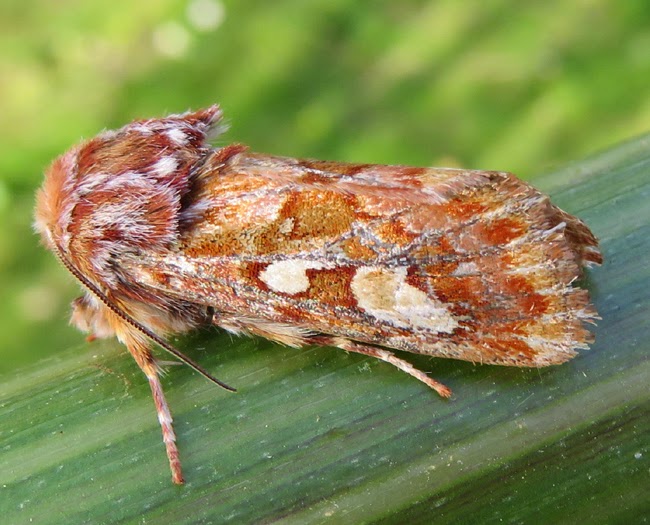After a few false alarms earlier in the month thinking the
mute swans were nesting, it now appears the pair on the park pond have finally chosen their spot amongst the reeds. It's going to be a well hidden nest once all the new reedmace stems grow up around it. The female was sitting on the nest, although probably not on eggs yet with the male adding more reed stems, mid afternoon on Thursday 23rd.
The sub-adult
grey heron was standing at the back of the pond, later flying onto the grazing fields.
The pair of
long-tailed tits have been busy over the last month building their nest in the bramble bush beside the pond.
The
sedge warbler was singing in short bursts from the edge of the park pond during Thursday afternoon. Most likely the same bird that came in a week ago. The
Cetti's warbler has also been singing in loud bursts every day, mainly from the pond towards the kestrels' oak tree. A
lesser whitethroat was singing from the back of the grazing fields.
Other birds seen at the pond was the pair of
little grebes, one pair of
tufted ducks was seen mating with three other pairs still around, also a pair of
shoveler, while a male
pochard was present on Monday 20th.
On the grazing fields 30+
black-tailed godwits and 30
redshank were present for the high tide roost on Thursday. Also present was a pair of
wigeon, 8
shelduck, 25+
teal, 2 little egrets
Around the park at least half a dozen
whitethroats have been singing, at least one
lesser whitethroat, 4
blackcaps and 3
chiffchaffs. A couple of
swallows have been seen over the park most days recently but no sand martins.
A late
fieldfare was seen near the park on Wednesday 22nd by Martin Cock.
At Maydays Farm on Sunday 19th, a
great white egret flew past Steve Entwistle, providing a good view as it headed up the Pyefleet channel. It was seen to drop down on its way towards the Strood but a subsequent search soon after failed to relocate it.
The next day Steve saw the
yellow-legged gull on the Strood and a
house martin near the allotments, then at dusk a
tawny owl in Shop Lane. On Thursday 23rd a pair of
red-legged partridge and
blackcap were seen at Maydays farm while the
cuckoo was heard. The Thorleys also reported hearing a
cuckoo in the area of Meeting Lane in recent days.
Other wildlife noted in the last few days include a
weasel by the park pond on Monday 20th, also an
adder and the first
speckled wood butterfly at the park while a
brown hare was seen dead on the East Mersea road near Bocking Hall. An
adder was seen again on the park on Tuesday 21st and a
slow-worm was found dead at the park two days later.
The first Island report of an
orange-tip butterfly was in Adrian Amos' garden along East Road on Wednesday 22nd along with a
brimstone butterfly and a
blackcap seen here too. The first
orange-tip sighting at the park was on Thursday 23rd.
Some
blackthorn bushes are still in full blossom around the country park, although other bushes were at their peak a fortnight ago.
Coinciding with the blackthorn in flower was this nationally scarce
sloe carpet moth that visited the moth trap at the park on Wednesday night. This is a different individual to the three trapped last week. The caterpillars feed on the blackthorn leaves.
The slightly milder night temperatures on Wednesday night saw 38 individuals of about 11 species noted by the next morning. Other moths noted included
northern drab, blossom underwing, early grey, pine beauty, powdered quaker, common quaker, hebrew character, oak-tree pug and
frosted green.
This
brimstone moth was found resting in the grass a few feet from the trap - the first of the year.

























.jpg)






























